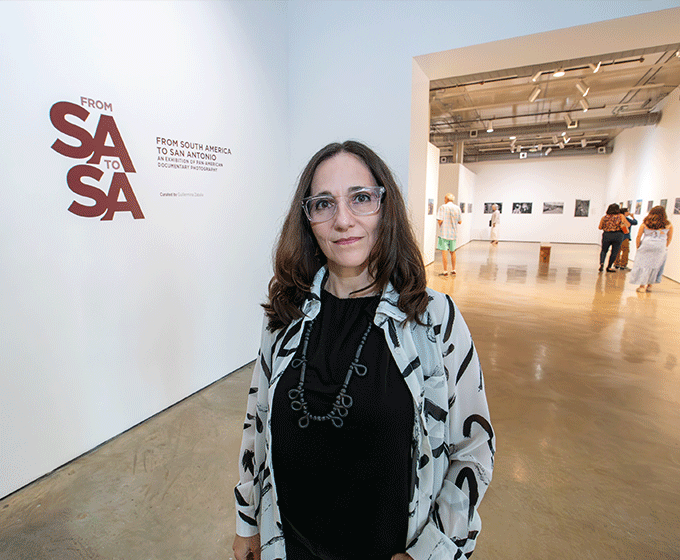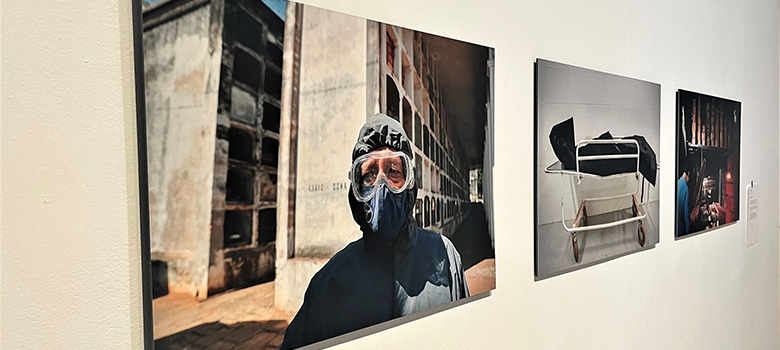
Guillermina Zabala Suárez's latest exhibit explores Photo Courtesy of Stacey Norton
AUGUST 31, 2023 — Guillermina Zabala Suárez is a professor of practice in the UTSA College of Liberal and Fine Arts’ Film and Media Studies program. A multidisciplinary artist and educator, Zabala Suárez’s works examine the intersection between individuals and their social-political-cultural environment.
She has showcased her works with film, mixed media and photography in museums, galleries and at film festivals – both nationally and internationally—including the McNay Art Museum, the Telluride Film Festival in Colorado and the Festival Internacional de Cine Independiente de Ourense in Spain. Additionally, her work is part of the UTSA Art Collection.
Recently, Zabala Suárez curated a new exhibit, “From SA to SA: From South America to San Antonio” showcasing the documentary work of 20 award-winning Latin American and Latinx photographers living in South, Central and North America. Housed at the Centro de Artes Gallery, the free exhibit runs until December 30.
UTSA Today spoke with Zabala Suárez about her latest work and her future projects.
What was your inspiration for “From SA to SA: From South America to San Antonio”?
GS: As an Argentine American artist and curator, I felt the urge to bring part of my history and culture to San Antonio. Throughout the years, I’ve been following the works of documentary photographers from Latin America as well as Latinx photographers from the U.S., and I’ve always been amazed by their powerful images and the impact of this medium. In 2019, Centro de Artes announced an open call for exhibit proposals, so I thought that this would be a good opportunity for this project.
Centro de Artes is an incredible space. It’s ample, it has two floors and it’s located in a great area. I applied and got selected but when COVID hit, Centro de Artes was forced to temporarily close their space. In 2021, they announced a new timeline for exhibits and “From SA to SA’s” opening got moved to Fall 2023.
When selecting photographers, what did you look for in their work? Was it a specific type of storytelling?
GS: I compiled these photographic chronicles by finding common narratives between South, Central and North America. My focus was the socioeconomic, political and cultural realities emerging from these regions. At the beginning of this project, I shared this concept with the photographers, and they sent me images based on these parameters. As I was reviewing them, I began to find connections and similarities within the overarching themes, the photographers’ perspectives and the social issues explored in those images. My goal was to select photographic series that capture stories seldom told and bring them to light.
The exhibit is divided by themes such as immigration, community, the COVID pandemic, women’s rights and indigenous stories. Within those sections, the audience will find the works of photographers from regions such as Chile, Brazil, Cuba, Mexico and the U.S.

“From SA to SA: From South America to San Antonio” is on display at Centro de Artes Gallery. Photo Courtesy of Stacey Norton
How can documentary photography fight social change, especially in Latin America and in Latinx communities in the U.S.? Why is this type of work important?
GS: Documentary photography is a way of capturing the struggles of our day-to-day reality. It serves as a witness to injustices and inequalities. It preserves historical moments. It reminds us of horrific incidents that should never be repeated. It encourages us to reflect on all these issues and it inspires us to keep fighting to better our communities. This work is important and necessary. Captured by these award-winning photographers who, in many cases, risk their lives to document their realities, these photographs carry those fleeting moments in history that otherwise will go unnoticed.
What do you hope the viewer takes away from “From SA to SA: From South America to San Antonio”?
GS: In an era where almost, everything is shared via fleeting screens, “From SA to SA” encourages the visitor to pause and appreciate a tangible set of images presented in front of them. Through striking imagery and compelling storytelling, I want to invite the audience to immerse themselves in the stories, the places and the people.
Tell me about the $5,000 grant you recently received from the City of San Antonio. What other project(s) do you have in the works?
GS: This grant is part of the Department of Arts & Culture’s Project Grants for Individual Artists. Every year, the city has an open call process, for which I applied and got selected. Fifty artists were selected this year.
Funding will support my next project, an interdisciplinary video installation that explores the mental and physical state of sexual assault survivors and reflects on women’s body rights. The piece consists of a series of linocut prints, mixed media photography and digital video. For this project, I will be researching and exploring iconography related to femininity and the representation of the female body from indigenous tribes based in San Antonio and the surrounding areas.
My focus will be on women’s role, their connection with nature – particularly with plants, flowers and mother earth – including their views on the significant passage from childhood to womanhood and how this journey is represented in their iconography. It will debut in early spring 2025.
UTSA Today is produced by University Communications and Marketing, the official news source of The University of Texas at San Antonio. Send your feedback to news@utsa.edu. Keep up-to-date on UTSA news by visiting UTSA Today. Connect with UTSA online at Facebook, Twitter, Youtube and Instagram.
Move In To COLFA is strongly recommended for new students in COLFA. It gives you the chance to learn about the Student Success Center, campus resources and meet new friends!
Academic Classroom: Lecture Hall (MH 2.01.10,) McKinney Humanities BldgWe invite you to join us for Birds Up! Downtown, an exciting welcome back event designed to connect students with the different departments at the Downtown Campus. Students will have the opportunity to learn about some of the departments on campus, gain access to different resources, and collect some giveaways!
Bill Miller PlazaCome and celebrate this year's homecoming at the Downtown Campus with food, games, giveaways, music, and more. We look forward to seeing your Roadrunner Spirit!
Bill Miller PlazaThe University of Texas at San Antonio is dedicated to the advancement of knowledge through research and discovery, teaching and learning, community engagement and public service. As an institution of access and excellence, UTSA embraces multicultural traditions and serves as a center for intellectual and creative resources as well as a catalyst for socioeconomic development and the commercialization of intellectual property - for Texas, the nation and the world.
To be a premier public research university, providing access to educational excellence and preparing citizen leaders for the global environment.
We encourage an environment of dialogue and discovery, where integrity, excellence, respect, collaboration and innovation are fostered.